Curse of Tippecanoe
The Curse of Tippecanoe (also known as Tecumseh's Curse or the 20-Year Presidential Curse) is the supposed pattern of deaths in office of presidents of the United States who won the elections in years that are evenly divisible by 20,[1] since the 1840 election. Because of the timing of presidential elections, these are also those taking place in years ending with 0. The presidents fitting this description were William Henry Harrison (elected in 1840), Abraham Lincoln (1860), James A. Garfield (1880), William McKinley (1900), Warren G. Harding (1920), Franklin D. Roosevelt (1940) and John F. Kennedy (1960).
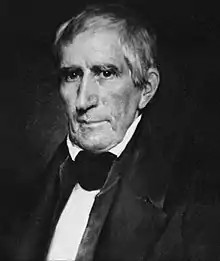
Ronald Reagan (1980) was seriously wounded by gunshot, but survived more than 15 years after his second term. George W. Bush (2000) survived his terms in office, despite an assassination attempt. Joe Biden (2020), the current President, is next in line to this purported curse.[1] Thomas Jefferson (1800) and James Monroe (1820) preceded the supposed curse, and outlived their presidencies by 17 and 6 years, respectively.
History
William Henry Harrison was elected president in 1840 and died in 1841, just a month after being sworn in. Ripley's Believe It or Not! noted a pattern in 1931 and again in 1948,[2] claiming that a president elected in a year ending in zero would die in office. They termed it the "Curse of Tippecanoe", a reference to a nickname for Harrison referencing his commanding role as governor of the Indiana Territory in the 1811 Battle of Tippecanoe.[3] The battle was part of Tecumseh's War, in which Shawnee leader Tecumseh and his younger brother Tenskwatawa organized a confederation of Indian tribes to resist the westward expansion of the United States. In a battle near the Tippecanoe River, Tenskwatawa and his troops were defeated by troops commanded by Harrison.
Strange as it Seems by John Hix ran a cartoon prior to the election of 1940 titled "Curse over the White House!" and claimed that "In the last 100 years, Every U.S. President Elected at 20-Year Intervals Has Died In Office!"[4] In February 1960, journalist Ed Koterba noted that "The next President of the United States will face an eerie curse that for more than a century has hung over every chief executive elected in a year ending with zero."[5] The first written account to refer to the source of the curse was an article by Lloyd Shearer in 1980 in Parade magazine.[6] It is claimed that when Tecumseh was killed in a later battle, Tenskwatawa set a curse against Harrison.[7]
Running for re-election in 1980, President Jimmy Carter was asked about the curse at a campaign stop in Dayton, Ohio on October 2 of that year while taking questions from the crowd. A high school student asked Carter if he was concerned about "predictions that every 20 years or election years ending in zero, the President dies in office." Carter replied, "I've seen those predictions. [...] I'm not afraid. If I knew it was going to happen, I would go ahead and be President and do the best I could till the last day I could."[8]
Exceptions
Since 1963, no president has died in office, even when elected on twenty-year marks.
The election of Ronald Reagan in 1980 was not followed by his death in office, despite him being seriously wounded in an assassination attempt within months of his 1981 inauguration.[9] Days after Reagan survived the shooting, columnist Jack Anderson wrote "Reagan and the Eerie Zero Factor" and noted that the 40th president had either disproved the superstition, or had nine lives.[10] Reagan, the oldest man to be elected president at that time, also survived treatment for colon cancer while in office. First Lady Nancy Reagan was reported to have hired psychics and astrologers to try to protect her husband from the effects of the curse.[11][12][13] However, the Reagans' son Ron revealed in his memoir that President Reagan began showing symptoms of Alzheimer's disease as early as three years into his first term as president.[14] Reagan left office on January 20, 1989, and ultimately died of pneumonia complicated by the Alzheimer's on June 5, 2004, at the age of 93.[15]
The president elected in 2000, George W. Bush, also survived two terms in office, which included a 2005 assassination attempt by Vladimir Arutyunian in which a live grenade was thrown at Bush and Georgian president Mikhail Saakashvili, but failed to explode.[16] He completed his final term in office on January 20, 2009.[17]
Of the eight U.S. presidents to have died in office, Zachary Taylor was elected in 1848, not in a year divisible by 20.[18] Furthermore, many U.S. presidents not falling into the pattern of years divisible by 20 have faced assassination threats, plots, or attempts. (See List of United States presidential assassination attempts and plots).
Criticism
The supposed curse demonstrates a number of logical fallacies, including confusing correlation with causation, cherry picking, and moving the goalposts.[1]
Timothy Redmond of Skeptical Inquirer writes:
The likelihood that the twenty-year presidential death cycle would come to pass by chance alone is extraordinarily low. But come to pass it did. As such, advocates of Tenskwatawa’s hex conclude that the cycle must have had a cause and that a curse was as good an explanation as any. The lottery fallacy, however, confuses the probability of one outcome with the probability of some outcome. [...] While the odds of the twenty-year presidential death cycle are low, the odds that some presidential death cycle would occur are rather high. If the twenty-year death cycle failed to develop, then perhaps a Virginia death cycle (every president from Virginia died while in office), or a William and James death cycle (every president with the first name William or James died while in office), or a whiskers death cycle (every president with facial hair died while in office) would have materialized in its stead. It is the endless number of improbable death cycles that renders such a death cycle so probable.[1]
In 2009, Steve Friess of Slate attempted to interview notable presidential historians and security experts such as Michael Beschloss, Doris Kearns Goodwin, and Richard A. Clarke on the alleged curse, but none of them returned his calls. When Friess asked Michael S. Sherry, his former American history professor at Northwestern University, the reply he got back was, "I doubt I have anything profound to say about this particular factoid, odd though it is."[19]
Applicable presidents
| Elected | Term of election | President | Death | Term of death | Cause of death | |
|---|---|---|---|---|---|---|
| 1840 | First |  |
William Henry Harrison | April 4, 1841 | First | Typhoid |
| 1860 | First | 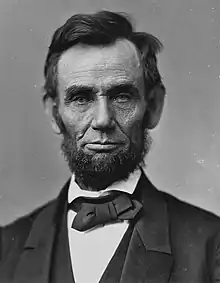 |
Abraham Lincoln | April 15, 1865 | Second | Assassinated |
| 1880 | First | 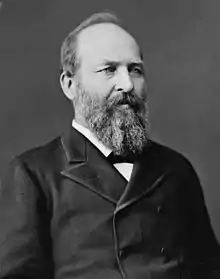 |
James A. Garfield | September 19, 1881 | First | Assassinated[20] |
| 1900 | Second | 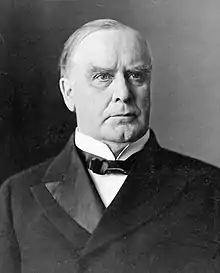 |
William McKinley | September 14, 1901 | Second | Assassinated |
| 1920 | First | 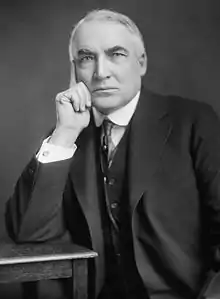 |
Warren G. Harding | August 2, 1923 | First | Heart attack |
| 1940 | Third | 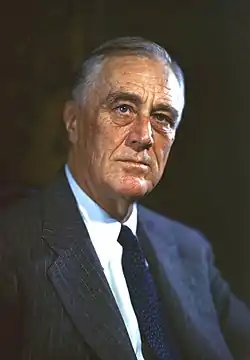 |
Franklin D. Roosevelt | April 12, 1945 | Fourth | Cerebral hemorrhage |
| 1960 | First | 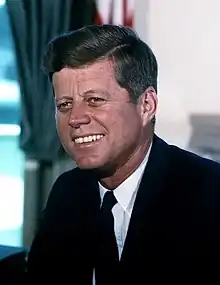 |
John F. Kennedy | November 22, 1963 | First | Assassinated |
| 1980 | First | 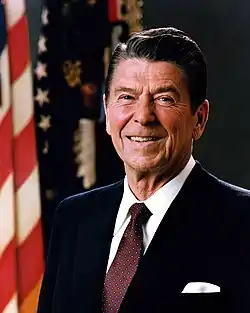 |
Ronald Reagan | June 5, 2004 (did not die in office) |
N/A | Pneumonia |
| 2000 | First | 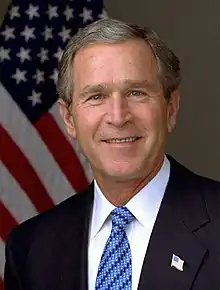 |
George W. Bush | Living (will not die in office) |
N/A | N/A |
| 2020 | First |  |
Joe Biden | Living | N/A | N/A |
See also
- List of presidents of the United States who died in office
- List of United States presidential assassination attempts and plots
- Similar curses and regularities:
- Bald–hairy, a regularity observed in the sequence of Russian rulers since 1825.
- Kennedy curse
- Redskins Rule
- Second-term curse
References
- Redmond, Timothy J. (November–December 2019). "The Presidential Curse and the Election of 2020". Skeptical Inquirer. Vol. 43 no. 6. Center for Inquiry. pp. 40–43. Archived from the original on 13 April 2020. Retrieved 13 April 2020.
- Ripley's Believe It or Not, 2nd Series (Simon & Schuster, 1931); an updated reference is on page 140 of the Pocket Books paperback edition of 1948
- The New Big Book of U.S. Presidents by Todd Davis, Marc Frey
- Oakland Tribune, November 5, 1940, p12
- Koterba, Ed (1960). "Pennsylvania avenue ponderings" (25). Hammond Times.
- Pohl, Robert (2013). Urban Legends and Historic Lore of Washington D.C. South Carolina: The History Press. ISBN 978-1540209030.
- Randi Henderson and Tom Nugent, "The Zero Curse: More than just a coincidence?" (reprinted from the Baltimore Sun), November 2, 1980, in Syracuse Herald-American, p C-3
- Carter, Jimmy (1981). Public Papers of the Presidents of the United States: Jimmy Carter, 1980-1981. p. 2031-32. ISBN 1623767806.
- Presidential Prophecies, History Channel
- The Sunday Intelligencer (Doylestown, PA), April 5, 1981, p 8
- Wadler, Joyce (23 May 1988). "The President's Astrologers". People. Retrieved 12 June 2013.
- Zuckerman, Laurence (16 May 1988). "Nancy Reagan's Astrologer". Time. Retrieved 12 June 2013.
- Cohen, Richard (22 October 1989). "Where Was Nancy's Astrologer?". Philadelphia Inquirer. Retrieved 12 June 2013.
- My Father at 100: A Memoir (Penguin)
- "Former President Reagan Dies at 93". Los Angeles Times. June 6, 2004. Retrieved July 9, 2013.
- "Bush grenade attacker gets life". CNN.com. January 11, 2006. Archived from the original on July 4, 2008. Retrieved June 11, 2016.
- "Obama inauguration: George Bush—the man who was no longer president". The Guardian (U.S. online ed.). London. 20 January 2009. Retrieved June 11, 2016.
- "Death of the President of the United States". Boston Daily Evening Transcript. July 10, 1850. Retrieved October 17, 2011.
- Friess, Steve (January 14, 2009). "Bush's Legacy: He Survived!". Slate. Retrieved November 16, 2020.
- Facts About The Presidents by Joseph Nathan Kane